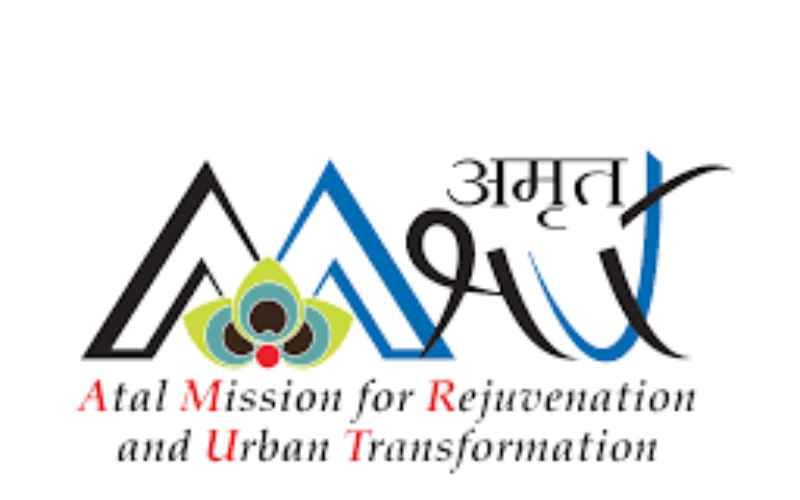India, with its rapidly growing urban population, faces numerous challenges in ensuring sustainable and inclusive urban development. Addressing these challenges necessitates a comprehensive approach to urban planning and management. One such initiative by the Government of India is the Atal Mission for Rejuvenation and Urban Transformation (AMRUT). Launched in 2015, AMRUT aims to establish infrastructure that could ensure adequate robust sewage networks and water supply for urban transformation by implementing urban revival projects. This blog delves into the AMRUT scheme, its objectives, components, and the impact it has had on urban India.

Understanding AMRUT
AMRUT is a central government initiative aimed at improving the quality of life in urban areas through infrastructure development and efficient service delivery mechanisms. The scheme targets 500 cities with the following objectives:
- Water Supply: Ensure every household has access to a tap with an assured supply of water.
- Sewerage: Develop sewerage networks and facilitate the treatment of urban sewage.
- Urban Transport: Develop efficient urban transport systems, including the development of non-motorized transport.
- Green Spaces: Create and maintain green spaces and parks for healthy living.
- Reforms: Implement reforms to improve governance and the delivery of services to citizens.
Key Components of AMRUT
The AMRUT scheme comprises various components designed to address the multifaceted needs of urban areas:
1. Water Supply and Management
- Infrastructure Development: Laying new water supply lines and rehabilitating existing ones.
- Water Treatment Plants: Establishing water treatment plants to ensure the supply of clean and potable water.
- Metering: Implementing universal metering to promote judicious use of water.
2. Sewerage and Septage Management
- Sewer Networks: Extending and improving the sewer network.
- Sewage Treatment Plants: Constructing and upgrading sewage treatment plants to handle urban waste effectively.
- Septage Management: Ensuring proper septage management, especially in areas without sewer networks.
3. Stormwater Drainage
- Drainage Systems: Developing and maintaining efficient stormwater drainage systems to prevent urban flooding.
- Urban Flood Management: Implementing measures to manage and mitigate urban flooding incidents.
4. Urban Transport
- Non-Motorized Transport: Promoting cycling and walking by developing dedicated pathways.
- Public Transport: Enhancing public transport facilities and services for better connectivity.
5. Green Spaces and Parks
- Parks and Open Spaces: Developing and maintaining parks, gardens, and open spaces.
- Urban Forests: Encouraging the creation of urban forests for ecological balance.
6. Reforms
- e-Governance: Implementing e-Governance initiatives for better service delivery.
- Urban Planning: Promoting better urban planning practices and the development of GIS-based master plans.
- Municipal Finance: Improving municipal finance systems for better resource management.
Impact of AMRUT
Since its inception, AMRUT has made significant strides in transforming urban infrastructure and service delivery:
- Increased Water Supply: Millions of households have gained access to clean and reliable water supply, improving public health and hygiene.
- Improved Sanitation: Enhanced sewerage systems and treatment plants have led to better sanitation and reduced environmental pollution.
- Efficient Urban Transport: Development of non-motorized transport options and improved public transport systems have reduced traffic congestion and pollution.
- Enhanced Green Spaces: The creation and maintenance of parks and open spaces have provided urban residents with areas for recreation and improved the overall urban environment.
- Strengthened Governance: Reforms and e-Governance initiatives have led to more transparent and efficient urban management.
Challenges and the Way Forward
Despite its successes, AMRUT faces several challenges, including:
- Funding Constraints: Ensuring adequate funding for the completion of projects.
- Coordination Issues: Coordinating between multiple agencies and stakeholders.
- Sustainability: Ensuring the long-term sustainability of infrastructure and services.
To address these challenges, continuous efforts are required in capacity building, better planning, and the active involvement of citizens and stakeholders in urban development processes.
Conclusion
The AMRUT scheme represents a significant step towards rejuvenating and transforming urban India. By focusing on essential infrastructure and service delivery, it aims to create cities that are not only livable but also sustainable. While challenges remain, the progress made so far underlines the potential of well-planned and executed urban development initiatives in improving the quality of life for millions of urban residents.
Top 20 FAQs about the AMRUT Strategy Scheme
1. What is the AMRUT scheme?
Answer: AMRUT (Atal Mission for Rejuvenation and Urban Transformation) is a central government initiative aimed at improving the quality of life in urban areas through infrastructure development and efficient service delivery mechanisms. It targets water supply, sewerage, urban transport, green spaces, and governance reforms in 500 cities.
2. When was the AMRUT scheme launched?
Answer: The AMRUT scheme was launched on June 25, 2015.
3. What are the main objectives of the AMRUT scheme?
Answer: The main objectives are to provide every household with a water tap, develop sewerage networks, improve urban transport systems, create green spaces and parks, and implement governance reforms for better service delivery.
4. Which cities are covered under the AMRUT scheme?
Answer: The scheme targets 500 cities, primarily those with a population of over one lakh, state capitals, and heritage cities.
5. How is the AMRUT scheme funded?
Answer: The funding for the AMRUT scheme is shared between the central and state governments. The central government provides a significant portion of the funds, while state governments and urban local bodies contribute the rest.
6. What are the key components of the AMRUT scheme?
Answer: The key components include water supply and management, sewerage and septage management, stormwater drainage, urban transport, green spaces and parks, and governance reforms.
7. How does AMRUT improve water supply?
Answer: AMRUT improves water supply by developing and rehabilitating water supply lines, establishing water treatment plants, and implementing universal metering to ensure judicious water use.
8. What measures are taken under AMRUT for sewerage and septage management?
Answer: Measures include extending and improving sewer networks, constructing and upgrading sewage treatment plants, and ensuring proper septage management in areas without sewer networks.
9. How does AMRUT address urban flooding issues?
Answer: AMRUT addresses urban flooding by developing and maintaining efficient stormwater drainage systems and implementing urban flood management measures.
10. What initiatives are included for urban transport under AMRUT?
Answer: Initiatives for urban transport include promoting non-motorized transport such as cycling and walking, and enhancing public transport facilities and services for better connectivity.
11. What is the focus of green spaces and parks development under AMRUT?
Answer: The focus is on developing and maintaining parks, gardens, and open spaces, and encouraging the creation of urban forests to promote ecological balance and provide recreational areas for residents.
12. What kind of governance reforms are promoted under AMRUT?
Answer: Governance reforms include implementing e-Governance initiatives for better service delivery, promoting better urban planning practices, developing GIS-based master plans, and improving municipal finance systems.
13. How are projects selected under AMRUT?
Answer: Projects are selected based on the Service Level Improvement Plan (SLIP) prepared by each city, which is then integrated into the State Annual Action Plan (SAAP) for approval and funding.
14. What role do urban local bodies play in AMRUT?
Answer: Urban local bodies (ULBs) are responsible for preparing and implementing the SLIPs, ensuring proper execution of projects, and maintaining the infrastructure developed under the scheme.
15. How is the progress of AMRUT projects monitored?
Answer: Progress is monitored through a comprehensive review mechanism, including regular reporting by ULBs, state-level reviews, and national-level monitoring by the Ministry of Housing and Urban Affairs.
16. What are the key achievements of the AMRUT scheme so far?
Answer: Key achievements include improved water supply to millions of households, enhanced sewerage systems, development of non-motorized transport options, creation of green spaces, and strengthened governance through e-Governance initiatives.
17. What challenges does the AMRUT scheme face?
Answer: Challenges include funding constraints, coordination issues among multiple agencies, and ensuring the long-term sustainability of infrastructure and services.
18. How does AMRUT promote community participation?
Answer: AMRUT promotes community participation by involving citizens in the planning and implementation process, encouraging feedback, and ensuring transparency in project execution.
19. What is the duration of the AMRUT scheme?
Answer: The AMRUT scheme is designed to be implemented over a period of five years, with the possibility of extensions based on progress and need.
20. Where can I find more information about the AMRUT scheme?
Answer: More information about the AMRUT scheme can be found on the official website of the Ministry of Housing and Urban Affairs (MoHUA) and through various government publications and reports on urban development.
Related posts:
 Smart Cities Mission – Government of India
Smart Cities Mission – Government of India
 Atal Pension Yojana: A Step Towards Financial Security in Old Age
Atal Pension Yojana: A Step Towards Financial Security in Old Age
 Gold Monetisation Scheme (GMS): A Comprehensive Guide
Gold Monetisation Scheme (GMS): A Comprehensive Guide
 Makar Sankranti: Embracing the Radiant Sun and Cultural Traditions
Makar Sankranti: Embracing the Radiant Sun and Cultural Traditions
 Kalpeni – A Tranquil Oasis in Lakshadweep
Kalpeni – A Tranquil Oasis in Lakshadweep
 Hanumangarhi Ayodhya: A Sacred Abode of Lord Hanuman
Hanumangarhi Ayodhya: A Sacred Abode of Lord Hanuman
 World Class Institutions Scheme: Elevating Indian Higher Education to Global Standards
World Class Institutions Scheme: Elevating Indian Higher Education to Global Standards
 WhatsApp Replaces Green Verification Badge with Blue One: What You Need to Know
WhatsApp Replaces Green Verification Badge with Blue One: What You Need to Know
 PM Jan Dhan Yojana: A Revolutionary Financial Inclusion Initiative
PM Jan Dhan Yojana: A Revolutionary Financial Inclusion Initiative
